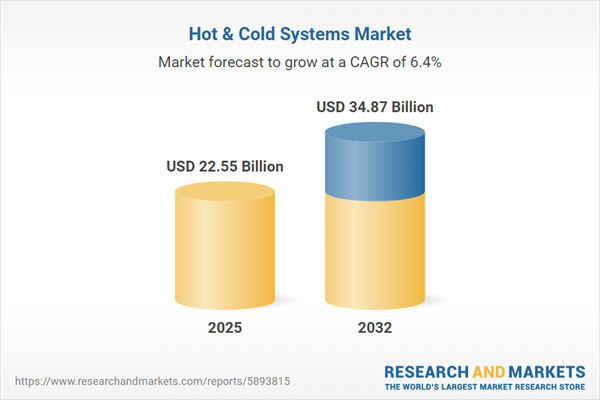Speak directly to the analyst to clarify any post sales queries you may have.
As environmental regulations tighten and sustainability moves up the C-suite agenda, the hot and cold systems market is undergoing transformation. Senior leaders are seeking strategies that deliver both operational efficiency and compliance, while positioning their organizations for long-term adaptability.
Market Snapshot: Hot and Cold Systems Market Growth Trajectory
The global hot and cold systems market is projected to rise in value from USD 21.20 billion in 2024 to USD 34.87 billion by 2032, reflecting a compound annual growth rate (CAGR) of 6.41%. This positive growth outlook is anchored by increasing demand for energy-efficient solutions across diverse sectors. Senior decision-makers are driving accelerated modernization and innovation agendas, as providers shift strategies to prioritize product integration, regulatory compliance, and alignment with the latest environmental standards. The market’s resilience is underscored by its ability to navigate evolving requirements while supporting organizations in meeting emerging operational and sustainability objectives.
Scope & Segmentation of the Hot and Cold Systems Market
- End Users: Commercial organizations focus on reducing total ownership costs and optimizing system reliability; industrial operators prioritize dependable solutions for critical facilities; residential buyers value energy efficiency and long-term comfort.
- System Types: Single-stage units offer fundamental control for stable environments; two-stage units manage fluctuating demands; variable-speed systems with inverter technology deliver dynamic responses to varying conditions for higher energy savings.
- Applications: HVAC stabilizes temperatures in buildings; process cooling is essential in regulated sectors such as food handling and bulk chemicals; advanced refrigeration supports the protection of pharmaceuticals and other sensitive store items.
- Distribution Channels: The ecosystem includes original equipment manufacturers, aftermarket service providers, representatives, independent distributors, and digital commerce platforms to address varied sourcing strategies and preferences.
- Energy Sources: Stakeholders select from electric, gas, and solar-powered technologies to fulfill operational needs and sustainability mandates, aligned with stringent compliance benchmarks.
- Regional Markets: The Americas, Europe, Middle East & Africa, and Asia-Pacific each bring unique infrastructure landscapes, regulation, and urban growth; these require nuanced go-to-market strategies and technology adaptation to meet localized needs.
- Technology Use: IoT integration, digital twin simulation, predictive analytics, and sustainable refrigerants all support increased transparency and system efficiency, enabling rapid, insight-driven decisions for business leaders.
Key Takeaways for Senior Decision-Makers
- Adopting real-time analytics enhances maintenance scheduling and supports more predictable and stable operations throughout all system portfolios.
- Choosing sustainable refrigerants and environmentally sound materials enables organizations to both meet current environmental objectives and prepare for evolving regulations.
- Flexible investment models, including solutions like energy-as-a-service, enable tailored scalability and budgeting for both short-term initiatives and long-term modernization.
- Expanding supplier relationships and strengthening domestic production capacity improves supply chain resilience, helping organizations anticipate and absorb disruptions.
- Effective collaboration between procurement and operations leads to more streamlined integration and better management of system lifecycles in multi-asset environments.
- Continuous monitoring of regulatory trends fosters organizational agility, supporting timely decision-making and facilitating compliance as market expectations change.
Tariff Impact on Component Supply Chains
Recent shifts in U.S. tariff policy have added complexity to the procurement of critical hot and cold system components. Organizations are responding by broadening supplier networks, favoring domestic alternatives, and prioritizing locally controlled manufacturing, which together help minimize risk and ensure critical supply chain continuity.
Methodology & Data Sources
This analysis features direct interviews with senior industry executives, comprehensive reviews of published technical documentation, and systematic evaluation of regulatory texts. All findings are independently validated to deliver decision-grade insights and reflect current market dynamics within thermal management.
Why This Report Matters for Senior Leadership
- Enables strategic planning and risk management in the hot and cold systems market through up-to-date analysis grounded in executive-level intelligence.
- Guides organizations in navigating regulatory, technological, and market complexity using insight from primary research and industry leadership.
- Supports robust capital allocation and prioritization, equipping executives to enhance resilience and respond efficiently to shifting customer or regulatory requirements.
Conclusion
Executives who act on timely market intelligence and leverage adaptive strategies will be better positioned to maintain operational continuity and pursue sustainable growth as the market for thermal management solutions continues to develop.
Additional Product Information:
- Purchase of this report includes 1 year online access with quarterly updates.
- This report can be updated on request. Please contact our Customer Experience team using the Ask a Question widget on our website.
Table of Contents
3. Executive Summary
4. Market Overview
7. Cumulative Impact of Artificial Intelligence 2025
Companies Mentioned
The companies profiled in this Hot & Cold Systems market report include:- Daikin Industries, Ltd.
- Carrier Global Corporation
- Johnson Controls International PLC
- Trane Technologies PLC
- Mitsubishi Electric Corporation
- LG Electronics Inc.
- Lennox International Inc.
- Fujitsu General Limited
- Bosch Thermotechnology GmbH
- Rheem Manufacturing Company
Table Information
| Report Attribute | Details |
|---|---|
| No. of Pages | 197 |
| Published | November 2025 |
| Forecast Period | 2025 - 2032 |
| Estimated Market Value ( USD | $ 22.55 Billion |
| Forecasted Market Value ( USD | $ 34.87 Billion |
| Compound Annual Growth Rate | 6.4% |
| Regions Covered | Global |
| No. of Companies Mentioned | 11 |









